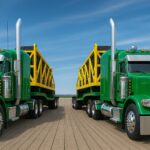Moving valuable freight safely and efficiently hinges on choosing the right trailer. Among the options, the Conestoga trailer stands out for its unique blend of protection, ease of loading, and versatility. In this article, we’ll explain what a Conestoga trailer is, explore its key benefits, outline the types of cargo it handles best, and compare it to flatbeds and dry vans so you can decide if it’s the right choice for your operation.
What Makes a Trailer “Conestoga”?
A Conestoga trailer combines the open-deck flexibility of a flatbed with the weather protection of an enclosed van. It features a rolling tarp system—called a tarp boom—that spans the length of the trailer.
To load, drivers slide the tarp back, exposing the flat deck underneath. Once cargo is secured, the tarp slides forward and locks into place, creating a tight, weatherproof seal. This innovation lets operators load from above like a flatbed, yet shield freight from rain, wind, and road debris as they would in a dry van.
Benefits That Truckers Appreciate
Truckers choose Conestoga trailers because they eliminate many of the common trade-offs between flatbeds and vans. For example, loading heavy machinery or oversized crates is as simple as on a flatbed—no side doors or roof bows to work around. At the same time, freight stays clean and dry thanks to the durable, PVC-coated tarp. That means you avoid expensive damage claims after unexpected storms or highway spray.
Moreover, Conestogas reduce load-securement time. Drivers can walk straight down the deck, hooking straps or chains directly to the cargo, and then slide the tarp back up in minutes. Faster securement translates into more loads per week and a healthier bottom line. Finally, because the tarp encloses the load, wind drag decreases compared to a flatbed carrying tarped freight, improving fuel economy on long hauls.
Ideal Cargo for Conestoga Trailers
Conestoga trailers excel when you need both easy top-loading and weather protection. Common applications include:
- Palletized goods that require forklift loading from the side or above
- Metal coils and sheet goods, where covering against rust is critical
- Lumber and building materials that must stay dry to avoid warping
- Finished goods like appliances or furniture that can’t tolerate road grit
When you haul freight that demands quick access yet needs shelter, a Conestoga trailer often delivers the best of both worlds.
Conestoga vs. Flatbed vs. Dry Van
Choosing the right platform involves balancing loading methods, cargo protection, and cost:
| Feature | Conestoga Trailer | Flatbed Trailer | Dry Van Trailer |
| Loading Style | Top and side loading under rolling tarp | Full open-deck loading | Rear and side door loading only |
| Weather Protection | Fully enclosed by sliding tarp | Requires manual tarping or none | Fully enclosed with rigid walls |
| Loading Speed | Fast tarp slide + direct deck access | Fastest deck access, but manual tarping | Slowest—must open doors and maneuver inside |
| Fuel Efficiency | Better than tarped flatbed, slightly below dry van | Lowest—high wind exposure | Best—smooth exterior, minimal drag |
| Maintenance Complexity | Tarp system needs regular inspection | Minimal—metal deck and frame only | Rigid walls need less frequent servicing |
As you can see, Conestoga trailers strike a middle ground. You gain most of a flatbed’s loading flexibility alongside nearly van-like protection, without the extensive manual labor of tarping each load.
Factors to Consider Before Choosing Conestoga Trailer
Before adding a Conestoga trailer to your fleet, consider these practical factors. First, inspect the tarp boom mechanism carefully—replace worn seals promptly to maintain a watertight enclosure. Next, calculate whether the slightly higher purchase price and tarp-system maintenance outweigh labor savings and reduced damage claims. Finally, review your typical routes: if your lanes involve frequent highway rain or snow, the added protection can more than justify the investment.
Final Thoughts
A Conestoga trailer can transform your heavy-haul or general freight operation by combining the rapid loading of a flatbed with the weatherproofing of a dry van. When you need both speed and protection, few options match its versatility. Ready to see what a Conestoga can do for your fleet?





